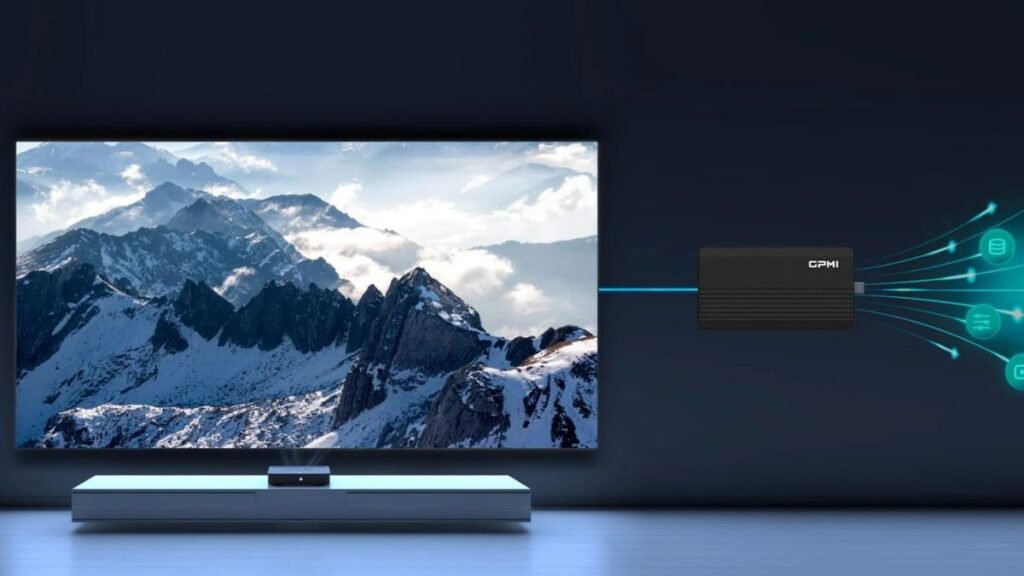A revolutionary new wired interface called GPMI (General Purpose Media Interface) is set to redefine the way we connect our audio and video devices. Recently unveiled by the Shenzhen 8K Ultra HD Video Industry Collaboration Alliance, GPMI aims to replace existing standards like HDMI, DisplayPort, Thunderbolt, and even USB by offering a universal, high-performance solution for modern multimedia needs.
- Also Check: Apple Rushed Five Airplane Shipments of iPhones from India to the US to Beat New Tariffs
What is GPMI?
GPMI is a next-generation wired media interface developed by over 50 leading Chinese tech companies, including Hisense, TCL, and Skyworth. This new standard integrates video, audio, networking, power delivery, and data transmission into a single cable, eliminating the need for multiple connections.
It comes in two versions:
- GPMI Type-C: Compatible with the USB-C standard, this version delivers 96 Gbps bandwidth and supports up to 240W of power delivery.
- GPMI Type-B: A proprietary connector offering 192 Gbps of bandwidth and a massive 480W power output, making it ideal for power-hungry devices and high-resolution displays.

How is GPMI Better Than HDMI, DisplayPort, Thunderbolt, and USB?
When compared with current industry standards, GPMI offers several key advantages:
| Interface | Bandwidth | Power Delivery |
|---|---|---|
| HDMI 2.1 | 48 Gbps | None |
| DisplayPort 2.1 | 80 Gbps | None |
| Thunderbolt 4 | 40 Gbps | 100W |
| USB4 (Extended Power Range) | 40 Gbps | 240W |
| GPMI Type-C | 96 Gbps | 240W |
| GPMI Type-B | 192 Gbps | 480W |
As seen above, even the more accessible GPMI Type-C surpasses the performance of USB4, HDMI 2.1, and Thunderbolt 4 in terms of bandwidth and power delivery. The proprietary Type-B variant nearly quadruples Thunderbolt’s bandwidth and power supply.
Key Advantages of GPMI
GPMI isn’t just about higher specs. It also introduces several next-gen features, including:
- Bidirectional Multi-Stream Transmission
- Full-Chain Security Protocols
- Simultaneous Data, Audio, and Video Transfer
- High Power Output for Larger Devices
- Reduced Cable Clutter
- Integrated Network and Peripheral Communication
- Universal Compatibility with USB Type-C Devices
These features make GPMI especially promising for Smart TVs, monitors, gaming consoles, and high-performance laptops.
Will GPMI Replace HDMI and DisplayPort?
While HDMI 2.1 and DisplayPort 2.1 support resolutions up to 10K and 16K, respectively, GPMI currently supports up to 8K streaming. However, the sheer efficiency, power delivery, and multi-purpose nature of GPMI offer a huge leap forward in terms of simplifying device connectivity.
Furthermore, GPMI reduces the need for multiple cables and external power sources, helping manufacturers and consumers cut down on e-waste and overall energy consumption.
Global Adoption and Future Outlook
As of now, GPMI is being developed and adopted primarily by Chinese tech companies. Devices with GPMI ports are expected to launch soon, starting with Smart TVs. It remains to be seen whether global tech giants like Sony, Intel, AMD, and NVIDIA will adopt this new standard, but the momentum is building.

If GPMI gains traction outside China, it could very well become the universal media interface standard of the future.
Final Thoughts
GPMI is more than just another audio-video connector—it’s a bold step toward unified, high-performance connectivity. With its massive bandwidth, high power output, and universal compatibility, GPMI has the potential to render current standards like HDMI, DisplayPort, and Thunderbolt obsolete.
- Also Check: vivo X200 Ultra Officially Teased in Stunning Colors: Key Specs, Camera Details, and Launch Date Confirmed
Stay tuned as we track GPMI’s adoption in upcoming consumer electronics. If you’re looking for the future of display and media connectivity, GPMI might just be it.









